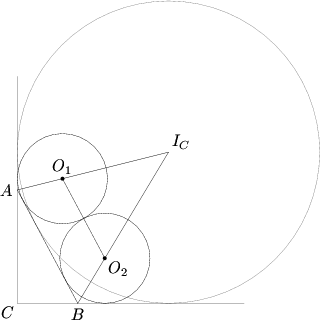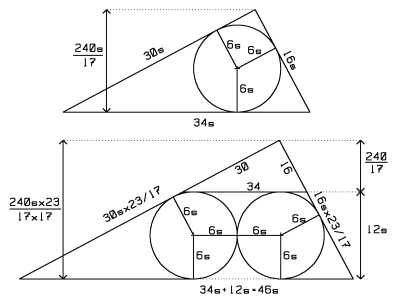2007 AIME I Problems/Problem 9
Problem
In right triangle ![]() with right angle
with right angle ![]() ,
, ![]() and
and ![]() . Its legs
. Its legs ![]() and
and ![]() are extended beyond
are extended beyond ![]() and
and ![]() . Points
. Points ![]() and
and ![]() lie in the exterior of the triangle and are the centers of two circles with equal radii. The circle with center
lie in the exterior of the triangle and are the centers of two circles with equal radii. The circle with center ![]() is tangent to the hypotenuse and to the extension of leg
is tangent to the hypotenuse and to the extension of leg ![]() , the circle with center
, the circle with center ![]() is tangent to the hypotenuse and to the extension of leg
is tangent to the hypotenuse and to the extension of leg ![]() , and the circles are externally tangent to each other. The length of the radius either circle can be expressed as
, and the circles are externally tangent to each other. The length of the radius either circle can be expressed as ![]() , where
, where ![]() and
and ![]() are relatively prime positive integers. Find
are relatively prime positive integers. Find ![]() .
.

|
Solution
Solution 1
Label the points as in the diagram above. If we draw ![]() and
and ![]() , we form two right triangles. As
, we form two right triangles. As ![]() and
and ![]() are both tangents to the circle, we see that
are both tangents to the circle, we see that ![]() is an angle bisector. Thus,
is an angle bisector. Thus, ![]() . Call
. Call ![]() and
and ![]() . We know that
. We know that ![]() .
.
If we call ![]() , then
, then ![]() . Apply the tangent half-angle formula (
. Apply the tangent half-angle formula (![]() ). We see that
). We see that 
![]() . Also,
. Also, ![]() . Thus,
. Thus,  , and
, and ![]() .
.
Similarly, we find that  .
.
Therefore, ![]() , and
, and ![]() .
.
Solution 2
Use a similar solution to the aforementioned solution. Instead, call ![]() , and then proceed by simplifying through identities. We see that
, and then proceed by simplifying through identities. We see that ![]() . In terms of
. In terms of ![]() , we find that
, we find that ![]() . Similarly, we find that
. Similarly, we find that ![]() .
.
Substituting, we find that ![]() . Under a common denominator,
. Under a common denominator, ![]() . Trigonometric identities simplify this to
. Trigonometric identities simplify this to ![]() . From here, it is possible to simplify:
. From here, it is possible to simplify:
Our answer is ![]() , and
, and ![]() .
.
Solution 3
Let the point where CB's extension hits the circle be G, and the point where the hypotenuse hits that circle be E. Clearly ![]() . Let
. Let ![]() . Draw the two perpendicular radii to G and E. Now we have a cyclic quadrilateral. Let the radius be length
. Draw the two perpendicular radii to G and E. Now we have a cyclic quadrilateral. Let the radius be length ![]() . We see that since the cosine of angle ABC is
. We see that since the cosine of angle ABC is ![]() the cosine of angle EBG is
the cosine of angle EBG is ![]() . Since the measure of the angle opposite to EBG is the complement of this one, its cosine is
. Since the measure of the angle opposite to EBG is the complement of this one, its cosine is ![]() . Using the law of cosines, we see that
. Using the law of cosines, we see that ![]() This tells us that
This tells us that ![]() .
.
Now look at the other end of the hypotenuse. Call the point where CA hits the circle F and the point where the hypotenuse hits the circle D. Draw the radii to F and D and we have cyclic quadrilaterals once more.
Using the law of cosines again, we find that the length of our tangents is ![]() . Note that if we connect the centers of the circles we have a rectangle with sidelengths 8x and 4x. So,
. Note that if we connect the centers of the circles we have a rectangle with sidelengths 8x and 4x. So, ![]() . Solving we find that
. Solving we find that ![]() so our answer is 737.
so our answer is 737.
Solution 4
By Pythagoras, ![]() . Let
. Let ![]() be the
be the ![]() -excenter of triangle
-excenter of triangle ![]() . Then the
. Then the ![]() -exradius
-exradius ![]() is given by
is given by
![]() .
.
The circle with center ![]() is tangent to both
is tangent to both ![]() and
and ![]() , which means that
, which means that ![]() lies on the external angle bisector of
lies on the external angle bisector of ![]() . Therefore,
. Therefore, ![]() lies on
lies on ![]() . Similarly,
. Similarly, ![]() lies on
lies on ![]() .
.
Let ![]() be the common radius of the circles with centers
be the common radius of the circles with centers ![]() and
and ![]() . The distances from points
. The distances from points ![]() and
and ![]() to
to ![]() are both
are both ![]() , so
, so ![]() is parallel to
is parallel to ![]() , which means that triangles
, which means that triangles ![]() and
and ![]() are similar.
are similar.
The distance from ![]() to
to ![]() is
is ![]() , so the distance from
, so the distance from ![]() to
to ![]() is
is ![]() . Therefore,
. Therefore,
![]() .
.
Hence, the final answer is ![]() .
.
Solution 5
Start with a scaled 16-30-34 triangle. Inscribe a circle. The height, ![]() and radius,
and radius, ![]() are found via
are found via ![]() where
where ![]() is the perimeter.
is the perimeter.
Cut the figure through the circle and perpendicular to the hypotenuse. Slide the two pieces in opposite directions along the hypotenuse until they are one diameter of the circle apart. Complete the two partial circles.
The linear dimensions of the new triangle are ![]() times the size of the original. The problem's 16-30-34 triangle sits above the circles. Equate heights and solve for
times the size of the original. The problem's 16-30-34 triangle sits above the circles. Equate heights and solve for ![]() :
:
![]()
![]()
![]()
The answer is ![]() .
.
Solution 6
Using homothecy in the diagram above, as well as the auxiliary triangle, leads to the solution.
See also
| 2007 AIME I (Problems • Answer Key • Resources) | ||
| Preceded by Problem 8 |
Followed by Problem 10 | |
| 1 • 2 • 3 • 4 • 5 • 6 • 7 • 8 • 9 • 10 • 11 • 12 • 13 • 14 • 15 | ||
| All AIME Problems and Solutions | ||











